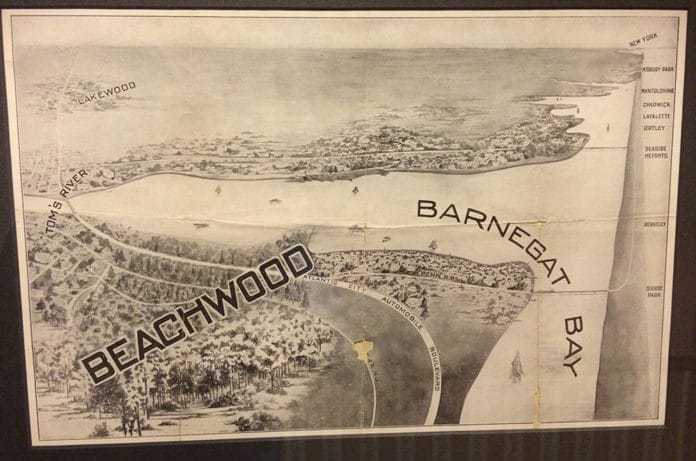
BEACHWOOD – Extra! Subscribe to the Berkeley Times and secure a lot in beautiful Beachwood! For just 11 cents a week, and $19.60, you can own a 20×100-foot lot in this pristine pine wilderness that rests on the Barnegat Bay!
An ad like that would certainly be ridiculous today. A hundred years ago, however, it had a different effect: It sold papers and it settled a town.
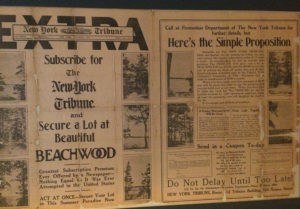
Bertram C. Mayo and Addison D. Nickerson (B.C. and A.D.) had been friends since college. Nickerson, an engineer, acquired the lots of barren pines and Mayo, an advertising expert, offered them as incentives to sell subscriptions. Therefore, the first settlers of Beachwood were a very literate crew.
There were 1,763 acres, split 18 lots to an acre. For $19.60, someone could buy a 20×100-foot lot and get a six month subscription to the New York Tribune on top of that. It is unclear if the subscription would be mailed to Beachwood, or be sent to the year-round address, which was most likely in northern New Jersey or New York.
It’s important to note that these were just Beachwood’s first settlers who lived in houses. A plaque hangs in the town hall immortalizing Indian Joe, a basket maker, who would live out of a wigwam, occasionally neighbored by “a number of gypsies.”
Beachwood was not Mayo’s first planned development, nor his last. His first was in Oakwood, California. Then, he created Lakewood, Michigan. Beachwood was his third. His fourth and last was also in New Jersey, and was called “Brown’s Mills in the Pines.”
Who’s Who In Beachwood
Much of Beachwood’s history is oral, put into concrete form for the first time by William Mill Butler, the town’s first board of education president, and member of several early boards, in his book “Who’s Who In Beachwood,” published in 1924. In 1924, there were just 6,000 taxpayers owning 28,000 lots. The budget in 1924 was $18,000.
Butler revered Mayo as someone who worked tirelessly to provide scenic bungalows at an affordable rate. Mayo himself would wind up selling the borough 209 lots, which were turned into present day Mayo Park.
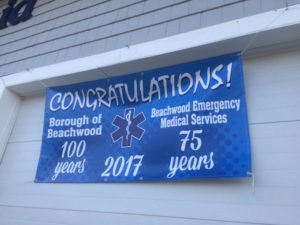
“Affordable” is a relative term then as now, since this was a resort community for people who could afford a second home and transportation. The ads in the back of the book were for jewelry, “Thomas’ Gluten Bread,” and “auto and carriage painting.” There were also ads for local spots like the Pine Beach Inn, Birdville in South Toms River and the Traco Theatre in Toms River.
The book lists residents, including the first baby born, Joseph Perry, in 1915. Many of them have a description of where their home was, and where they lived the rest of the year. For example: Ackerman, Emily E., north corner of Spring Street and Forepeak Avenue, Block D-28. Other address 622 Hackensack Plank Rd, Weehawkin.
Some residents were able to add a little personal information, such as a singer who went on for a few pages, and Butler himself, who took time to mention the comic opera he wrote and a book about Paraguay he was paid by that nation $500 in gold to write. There were also several people in the newspaper business, as well as artists, engineers, a surgeon and the borough’s first ice dealer. The book also included a phone listing where each line had very few digits, and a Central Railroad schedule.
This volume provides quite a cross section of what community life was like in those years, at least from the point of view of the ruling class. It was written by Butler, not Indian Joe, after all. Butler wrote:
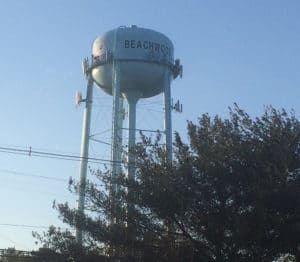
“The time may be not far distant when we shall be a winter as well as a summer resort, with increasing opportunities for development, prosperity, and healthful recreation and enjoyment. For the attainment of this greatness and eventual national distinction, two things are absolutely necessary. First, the preservation of the pines without which the distinctive character, charm and attraction of Beachwood would be wiped out; and, second, the rigid cooperation of the present inhabitants to guard well the character of those who are encouraged to settle among us. No commercial consideration or prospect of gain should tempt those who love and honor this lovely spot, to do anything that would lower the standards of its property owners, and we should take an equal pride in seeing our ordinances enforced so that Beachwood may continually add to its reputation as a decent, law-abiding Christian community.”
One particular note that definitely changed in the last 100 years was this quote by Butler: “The borough is restricted so far as its inhabitants are concerned, all deeds providing that only persons of the Caucasian race may own or lease property here.”
It described Beachwood’s location as being on the arm of the Barnegat Bay, but not, “strictly speaking,” on a river. They were wrong about that, too.
A note urged women to curb their modesty at the bathing beaches. Butler blamed the shortage of young men after the World War (a horror that will never come to pass again) as a reason that women were showing more skin in order to attract whoever was left.
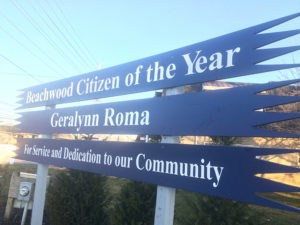
The author celebrated the community and how if they needed something, they would pull together to get it done. They wanted a library, so they got together to start one. They needed a fire truck, so they raised funds for that, too. The first house of worship was similarly built out of necessity, through charity, volunteerism, and hard work.
As the community grew, and the cost of living increased, the residents were feeling some taxation without representation. Still part of Berkeley Township, they wanted their taxes to go to Beachwood improvements only. So, in 1917, a group of the property owners wrote a bill and presented it to the legislature. It took only a few months for a bill that carved one town out of another town to be written and passed into law.
There was a strong respect for the environment, even though the residents were moving into the pristine woods. An ordinance forbade the unnecessary cutting of pines, for the curative pine air was thought to heal invalids and treat such ills as insomnia, catarrh, and infantile paralysis.
Truly, the first inhabitants of this small town really loved the community and location here, as is evidenced from a song that Butler wrote in his book:
“I’ll sing you no ambitious lays
Of war and war’s a’arms;
My song shall be of Beachwood days
And Beachwood’s many charms.”
Beachwood’s centennial will be celebrated throughout the year:
- March 22 is the actual 100th birthday.
- The Memorial Day parade will have a display honoring the 100th on the fire trucks, first aid and police vehicles.
- Summer Fun Nights on Monday evenings will have centennial themes.
- July 4 will have giveaways honoring the 100th birthday during the fireworks on the Toms River, which is actually run by Beachwood.
- Beachwood’s 2nd Annual Community Day will be on August 26, from noon to 4 p.m. at Birch and Surf Park. There will be t-shirt and other giveaways. There will be a lot of family entertainment such as inflatables, pony rides, face painting, craft vendors, and food vendors. Municipal and volunteer services will also have booths and activities. Although the event is free, some of the vendors do charge.
- The annual bonfire on October 28 will have centennial themed fun.






